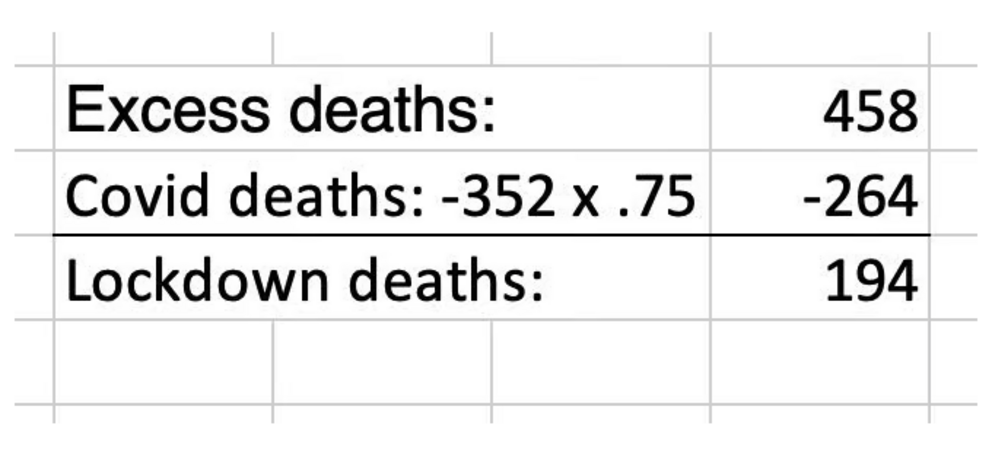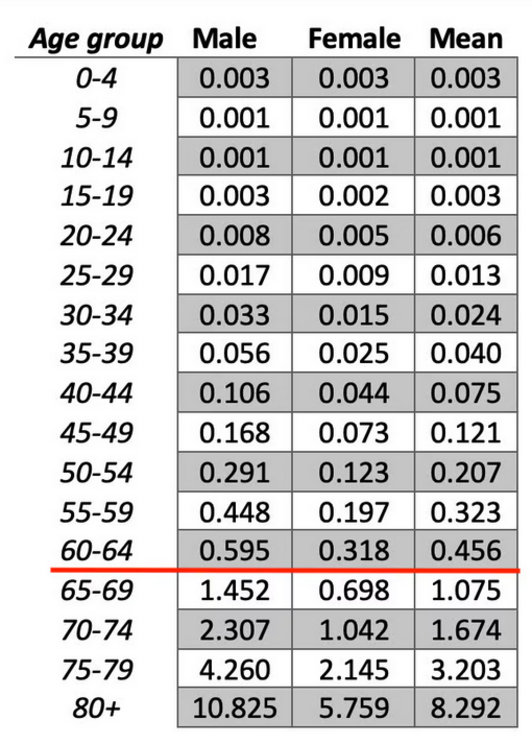Lockdown deaths in 2020 were 42% of excess deaths
There were virtually no Covid vaccinations given in 2020 (0.8 percent of population, and only 18 Covid vaccine deaths reported to VAERS), which makes it an ideal year for analyzing excess Covid deaths vs. excess lockdown deaths, which I am defining to include all excess deaths above Covid deaths, including iatrogenic deaths, and all other Nonpharmaceutical Intervention-caused deaths. Excess deaths, of course, are those above the actuarily expected number of deaths in the year that are predictable.
The relevant numbers recorded for 2020 are as follows, in thousands:

The 2020 excess deaths estimate is from the BMJ. Total CDC-recorded Covid deaths in 2020 are from 91-divoc.com. Covid deaths in 2020 were recorded liberally, including many “with Covid” deaths.
Dr. Deborah Birx, on the central Covid committee, estimated that 25 percent of Covid deaths were probably better attributed to other causes. Therefore the 352,000 Covid deaths are multiplied by 0.75, yielding 264,000 Covid deaths. Many would say Birx’s estimate of “with Covid” deaths is probably low.
Lockdown deaths in 2020 at 194,000 are 42 percent of total excess deaths. This is a huge amount. With a data lag of a few weeks, the CDC was publishing Covid and non-Covid excess deaths throughout 2020, so policymakers should have been aware of the collateral damage their policies were causing at the time. Governments were given credible warnings about the dangers of lockdowns, but did not listen.
And this analysis does not even contemplate the long-term damages to children’s education, small business owners and their families, the human capital and social fabric of the nation. The effects of trauma, especially social isolation, can be severe, and last for years (cf. The Body Keeps the Score).
There can be no debate about whether lockdowns “worked.” They were democidal and totally unjustified. The CDC estimated in 2020 that the infection fatality rate of SARS-Cov-2 was ~0.26 percent, about two and a half times that of influenza (this reference has been scrubbed from cdc.gov). The CDC later revised their estimate up to 0.65 percent. A representative age-stratified estimation from 2020 is shown below (see also Ioannidis article).

For men under 45 and women under 55 the risk is about the same as the flu (~0.1 percent). The steep age gradient, disputed by no one, ensures that those in the low risk groups can go on with life without incurring excessive risk. There were also significant correlations with comorbidities.
So I am adding my voice to the growing chorus shouting that the pandemic policies made no sense and were not about health at all. Given the knowledge of IFRs and this analysis, both available to policymakers contemporaneously, the perversity of their lockdown mandates is inescapably obvious.
My recommendation is that if your state or federal authorities try to lock you down again, do not comply.

